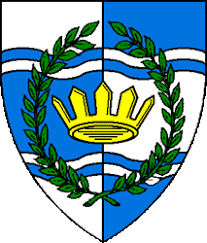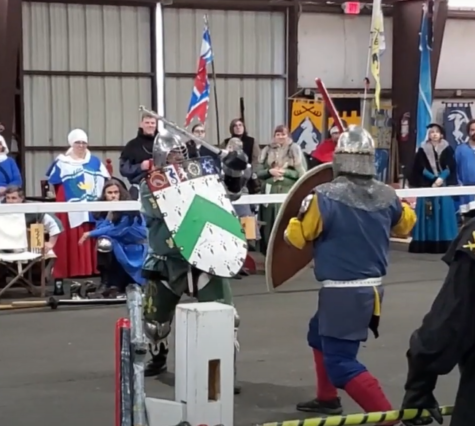The SCA-a True Blast From the Past
The SCA, or the Society for Creative Anachronism, is “an inclusive community pursuing research and re-creation of pre-seventeenth century skills, arts, combat and culture,” according to the official website. While this community is widely unknown by newer generations, the aspects of this community is an outstanding display of how kind people can be. Today, we will be gazing into the looking glass of what the SCA truly is.
Rules
The SCA has a few rules for those attending events, so it’s important that one knows these rules before attending an event. Firstly, you must wear medieval clothing. Modern clothes, nicknamed ‘mundane’ clothes by participants, are not to be worn at events. This is because, unlike the more well known Renaissance fair, the SCA requires time-accurate garments because of the focus on historical accuracy. Another rule is you should have a coat of arms to help identify you. A coat of arms is a design or pattern that helps distinct you from other participants. Whether it’s something you wear, a flag on your camp, or if it’s on a shield, a coat of arms is one thing that can make you stand out. Other than that, there aren’t many rules to being in the SCA. An Important thing to know, however, is that the SCA has differen t kingdoms depending on where one lives. The United States alone is divided into twenty different kingdoms, and here in Virginia lies the kingdom of Atlantia, represented by a crown surrounded by a laurel and a blue and white wave-type pattern as its coat of arms. Overall, it’s critical to follow these rules because it will make one’s experience in the SCA more enjoyable.
t kingdoms depending on where one lives. The United States alone is divided into twenty different kingdoms, and here in Virginia lies the kingdom of Atlantia, represented by a crown surrounded by a laurel and a blue and white wave-type pattern as its coat of arms. Overall, it’s critical to follow these rules because it will make one’s experience in the SCA more enjoyable.
Ranking
Within the SCA, the roles within the community are very important. For newcomers to the SCA, it might help one to know these roles. So, when it comes to the attendees of events, those with no rank are referred to as ‘My Lord’ or ‘My Lady.’ If one sees a person wearing a crown or coronet, they are usually a person of importance. Most of the time, this means that that person either is or was formerly royalty of a kingdom. Starting off at the highest point, a King or Queen are current royalty, having won the title in trial by combat. One can refer to these people as ‘Your Majesty.’ The next step down on the hierarchy is naturally Prince and Princess. It’s important to know that there are two different types of Princes and Princesses- Crown and Territorial. The Crown Prince and Princess win trial by combat in a kingdom, and they are to be called ‘Your Highness.’ The other kind of Prince and Princess are Territorial, and they rule a Principality. A Principality is a subdivision or territory within a kingdom, and their way of address varies from kingdom to kingdom. Once someone has served as King or Queen twice, they become a Duke or Duchess, and are to be referred to as ‘Your Grace’. If they have served as a Prince or Princess in a Principality at least once, they are a Viscount or Viscountess. Once someone has served as King or Queen once, they are known as a Count or a Countesss. There is also a Count Baron or Baroness, which are people rewarded by the crown for excellent service. These are all referred to as ‘Your Excellency’. Sometimes, It can be hard to tell what rank someone is from just a first look, so if there’s ever a person of whom you can’t determine their rank, just refer to them as ‘Your Excellency’. Usually though, It’s just safe to do a quick bow whenever one passes a person wearing a crown.
Armored Combat
‘Trial by combat’ is the only way for one to become a King or Queen of a kingdom. Armored combat is described as “a combat sport developed by the in which participants in protective body armour compete in mock combat, individual tournaments inspired by forms of historical combat practiced in medieval Europe,” according to the offical SCA website. The requirements are as follo ws- one must be wearing protective armor that is historically accurate, at least the protective armor that is in view. This can include chainmail, metal, and other materials. One must also wear a helmet, so that one can protect their face. The swords and spears used in armored combat are made of rattan and wrapped with duct tape. This is because not only is rattan hard to snap, its weight also replicates the weight of a steel sword. If one wants to start the process of fighting in a crown tournament, one must become a squire and be mentored by a seasoned fighter, or a knight. Knights are easily recognizable by their white belts, and squires are seen wearing red belts. It is also required that knights have swords, and yes, this sword is the real deal. This is because during a knighting ceremony, all of the knights in the kingdom place their swords on the shoulders of a person being knighted as they stand before the king. Unlike the actual renaissance, however, any person of any gender can become a knight with enough skill. To become a ruler of a certain Kingdom or Principality, one must win in a tournament against other knights to become a prince, and then become a ruler. The rulers serve for a total of around nine months, with three months being the Crown Prince and Princess and six months being the King and Queen. There are Crown tournaments two times a year to choose new rulers. Armored combat is a very important aspect of the SCA because this combat system decides who rules over different kingdoms, and it is also very important to the culture of the SCA overall.
ws- one must be wearing protective armor that is historically accurate, at least the protective armor that is in view. This can include chainmail, metal, and other materials. One must also wear a helmet, so that one can protect their face. The swords and spears used in armored combat are made of rattan and wrapped with duct tape. This is because not only is rattan hard to snap, its weight also replicates the weight of a steel sword. If one wants to start the process of fighting in a crown tournament, one must become a squire and be mentored by a seasoned fighter, or a knight. Knights are easily recognizable by their white belts, and squires are seen wearing red belts. It is also required that knights have swords, and yes, this sword is the real deal. This is because during a knighting ceremony, all of the knights in the kingdom place their swords on the shoulders of a person being knighted as they stand before the king. Unlike the actual renaissance, however, any person of any gender can become a knight with enough skill. To become a ruler of a certain Kingdom or Principality, one must win in a tournament against other knights to become a prince, and then become a ruler. The rulers serve for a total of around nine months, with three months being the Crown Prince and Princess and six months being the King and Queen. There are Crown tournaments two times a year to choose new rulers. Armored combat is a very important aspect of the SCA because this combat system decides who rules over different kingdoms, and it is also very important to the culture of the SCA overall.
Events
With all of the rules, roles, and combat explained, it is now time to explain the events themselves. Within the SCA, there are events almost every weekend in the warmer months of the year. These events vary in size, from a smaller event ranging from around 50-200 people to the largest event, Pennsic, having over 10,000 people in attendance in 2022. At these events, one can usually find volunteer opportunities, martial activities like axe throwing and archery, armored combat, skill-learning classes like medieval calligraphy, weaving, knitting, sewing, and much more. The main star of these events, however, is usually the social aspect. Whether it’s knight’s meetings, late-night parties lit by candlelight, ginormous feasts, or just sitting around a fire, participants in the SCA love to socialize.
Conclusion
Overall, the SCA is an amazing community filled with kind, genuine, selfless people. The SCA was founded over 50 years ago, but this ever-evolving community is in danger of dying out as the numbers have been on a decline in recent years. With many retiring from the SCA and not many new members, it is feared that the SCA might completely disappear one day. In order to keep the SCA running, it is important to keep the legacy going.


